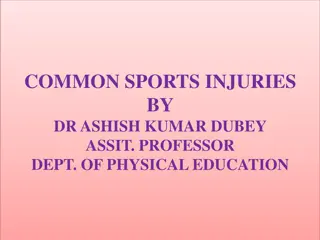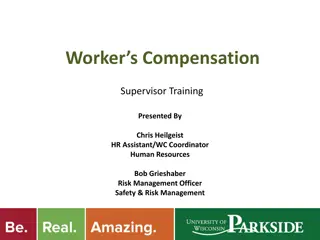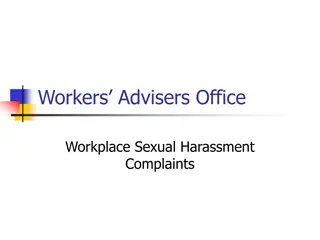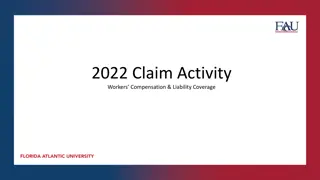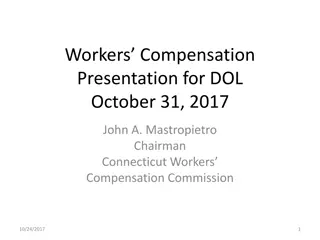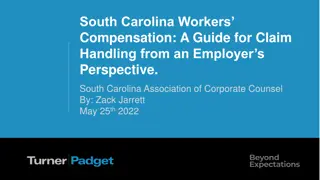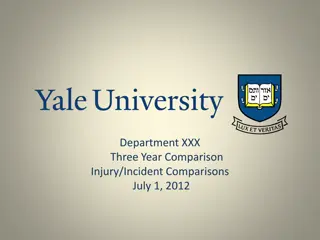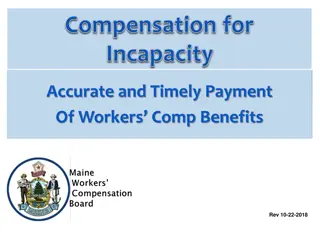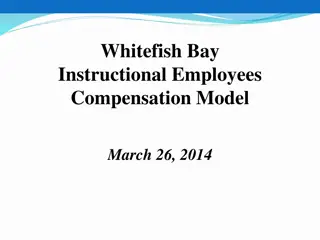Understanding Gillette Injuries in Minnesota Workers' Compensation
In Minnesota workers' compensation, Gillette injuries refer to cumulative trauma that disables an employee over time, as opposed to a distinct event. These injuries are recognized based on the Gillette v. Harold case, where the Minnesota Supreme Court highlighted the cumulative effects of daily work duties leading to disabling conditions. Examples include carpal tunnel syndrome from repetitive activities. Factors determining Gillette injury occurrence include the date of disablement and events indicating disability culmination.
Download Presentation

Please find below an Image/Link to download the presentation.
The content on the website is provided AS IS for your information and personal use only. It may not be sold, licensed, or shared on other websites without obtaining consent from the author. Download presentation by click this link. If you encounter any issues during the download, it is possible that the publisher has removed the file from their server.
E N D
Presentation Transcript
Dean M. Salita Areas of Practice Personal Injury Wrongful Death Workers Compensation Bar Admissions Minnesota Wisconsin U.S. District Court Classes/Seminars Frequently lecturer, Continuing legal education seminars on various legal topics Honors and Awards Martindale Hubbell awarded AV rating Named a Super Lawyer Professional Associations and Memberships Minnesota State Bar Association, Member Minnesota Association for Justice American Association for Justice Hennepin County Bar Association Minnesota Association for Justice Worker's Compensation, Chairman
Minnesota Statute 176 Minnesota Worker s compensation is governed by Minnesota Statute 176. Must be in the course and scope of employment Dykhoff case Specific v Gillette injuries Occupational Injuries
In the course and scope The next time you decide to lift someone s spirits, lift with your legs and not your back.
Gillette Injuries A Gillette injury is a concept in Minnesota workers compensation. A Gillette injury occurs when the cumulative effects of minute, repetitive trauma are serious enough to disable an employee. The term Gillette came from the case in which this type of injury was first recognized by the Minnesota Supreme Court: Gillette v. Harold, Inc.1 Based on that case, a workers compensation injury is not limited to one distinct event (such as a fall resulting in a broken arm) but may extend over a continuous period of time. The court also noted that in the course of one s ordinary duties, injuries may occur daily which may cause minimal damage, the cumulative effect of which in the course of time may be as injurious as a single traumatic occurrence which is completely disabling. Examples of work that has been found to cause Gillette injuries are: assembly line, clerical/secretarial, construction or other occupations involving repetitive activities such as bending, stooping, lifting, standing or walking. For example, carpal tunnel syndrome caused by work activity may be the result of a Gillette injury.
Gillette Continued There are various factors that determine when a Gillette injury occurred. 1. A Gillette injury is considered to have occurred on the date of disablement. 2. Initially, courts held that the date of a Gillette injury was established when there was an ultimate breakdown ; an ultimate breakdown occurred when an employee lost time from work due to the Gillette injury. 3. The courts broadened the meaning of the date of disablement and now consider other ascertainable events that evidence the culmination of a disability. 4 Examples of these ascertainable events are: modification of job duties due to doctor s restrictions;
Gillette Continued 4. Examples of these ascertainable events are: modification of job duties due to doctor s restrictions; 5. the date the employee initiated medical attention; 6. the date of an MRI scan and of a definite diagnosis; 7. when the employee s treating doctor determined the condition was related to the worker s employment; 8. when the employee s symptoms recurred after they had previously subsided; 9. and when the employee sought regular medical care even though the employee had not lost significant time from work.
Your Role as Patients Chiropractic Doctor Initially, courts required an employee to prove specific work activities caused specific symptoms that led to a disability. However, in a later case, the Minnesota Supreme Court held that an employee need only prove a causal connection between his or her ordinary work and the ensuing disability. The employee s testimony alone is not enough to establish the connection; the finding depends mainly on medical evidence. The medical provider must have adequate foundation of the actual nature of the employee s work duties to determine those duties caused the employee s symptoms. Your documentation of your patient s work history is critical!!!
What Benefits can an injured employee get? 1-Medical Benefits 2-Wage Loss benefits Temporary Total Disability (TTD) Temporary Partial Disability (TPD) Permanent Total Disability (PTD) 3- Permanent Partial Disability (PPD) 4-Vocational Rehabilitation benefits QRC/Retraining
Admitted v Denied claims Admitted claims are claims that are picked up. The employee is generally entitled to medical benefits for the rest of their life as long as the treatment fits the statute and the parameters. CHIROPRACTIC CARE (among others) has rotten limitations Admitted claims 12 weeks plus potential for and additional 12 visits DENIED NONE OF THIS APPLIES except fee schedule
Treatment Parameters The Minnesota Workers Compensation Rules set forth treatment parameters for passive care, including chiropractic treatment. These parameters are essentially guidelines for determining how much chiropractic treatment is reasonable and necessary to cure or relieve the effects of the work injury. Generally, the parameters permit 12 weeks of passive care or treatment to cure or relieve the effects of a work- related injury.
Treatment Parameters Continued The workers' compensation treatment parameters are in Minnesota Rules Parts 5221.6010 through 5221.6600. The parameters apply to all dates of injury and all health care providers.
Additional 12 Treatments. Twelve additional treatments over the course of a year may be permitted if (1)the employee is released to work or is permanently totally disabled and the additional passive treatment results in progressive improvement in, or maintenance of, the functional status achieved during the initial twelve weeks of passive care, (2)the passive treatment cannot be given on a regularly scheduled basis, .
Additional 12 Treatments Continued (3) the doctor must document a plan to encourage the employee s independence from and decreased reliance on ongoing treatment, (4) the employee must undergo active treatment modalities during this period in addition to the passive care, (5) the additional twelve weeks of passive care must not delay surgical intervention or an evaluation for chronic pain, (6) the passive care is not to treat chronic pain syndrome.
Departures A departure from the passive treatment parameters for work related neck or back injuries may also be appropriate if: (1) there is a documented medical complication of the condition, (2) if the prior treatment did not meet the accepted standards of practice, (3) where the treatment is necessary to assist the employee in the initial return to work where the employee s work activities place stress on the body part affected by the work injury, or (4) where there is an incapacitating exacerbation of the employee s condition.
Departures Continued The Rules also permit a departure where the treatment meets two of the following three criteria, which must be documented in the medical records: (1) the employee s subjective complaints of pain are progressively improving as evidenced by documentation in the medical record of decreased distribution, frequency or intensity of symptoms, (2) the employee s objective clinical findings are progressively improving, as evidenced by documentation in the medical records of resolution or objectively measured improvement in physical signs of injury, or (3) the employee s functional status, especially vocational activity, is objectively improving as evidenced by documentation in the medical record, or successive reports of workability, of less restrictive limitations on activity.
Rare Cases Finally, even if the prescribed treatment does not fall into one of these exceptions to the parameters, the Minnesota Workers Compensation Court of Appeals, as confirmed by the Minnesota Supreme Court, held that a departure is warranted in those rare cases in which departure is necessary to attain proper treatment.
DOCUMENT DOCUMENT DOCUMENT ALWAYS DOING THIS WITH GOING TO COURT IN MIND JUDGES LIKE DETAIL AND SEEING THAT PROVIDER KNOWS THEIR PATIENT AND CAN SUPPORT GOOD LEGIBLE NOTES GOOD LEGIBLE NOTES GOOD LEGIBLE NOTES Is that clear?
HOW DO I GET PAID (pay attention) The Minnesota workers' compensation statutes entitle an injured employee to reasonable and necessary medical treatment or supplies to cure or relieve the effects of the work injury. The employer is required to furnish medical treatment as described by Minnesota Statutes 176.135 Subd. 1, including psychological, chiropractic, podiatric, surgical and hospital treatment. 5221.4020 DETERMINING FEE SCHEDULE PAYMENT LIMITS. 5221.4060 CHIROPRACTIC PROCEDURE CODES.
Reasonable and Necessary The question of whether chiropractic care is reasonable and necessary is more than whether the employee experiences temporary relief. In a number of cases, this court has identified factors which should be considered in determining whether chiropractic treatment is reasonable and necessary. Horst v. Perkins Restaurant, 45 W.C.D. 9 (W.C.C.A. 1991); Selander v. Healey Ramme Co., slip op. (W.C.C.A. July 14, 1993); Bordeau v. Green Touch Indus., No. WC06-131 (W.C.C.A. Aug. 31, 2006).
Reasonable and Necessary Continued The factors vary depending on the facts of each case, but generally include documentation of the details of the treatment, including: 1. The evidence of a reasonable treatment program; frequency and duration of treatment, showing treatment on an as needed basis instead of a on a set schedule; 2. the degree and duration of the relief obtained; 3.appropriate referral to other providers; the effect of the treatment on the employee s employability; and 4.The cost of the treatment in light of the relief provided.
Lets talk about the most important thing
No no no no no no no no no no no no no
Your notes must be legible and thorough Insurance company can read Patient is happy Correlates to diagrams and history More professional Judges will be able to Read Again Judges will be able to read
PPD-Permanent Partial Disability Minnesota Rules 5223.0300 through 5223.0650 5223.0300 Workers' compensation permanent partial disability schedules 5223.0310 Definitions 5223.0315 Pre-existing impairments 5223.0320 Face, nose, mouth or throat 5223.0330 Eye 5223.0340 Ear 5223.0350 Skull defects 5223.0360 Central nervous system 5223.0370 Muskuloskeletal schedule; cervical spine 5223.0380 Muskuloskeletal schedule; thoracic spine 5223.0390 Muskuloskeletal schedule; lumbar spine
Restrictions and Functional Capacity Evaluation Restrictions on patient should be in writing. They are not legally necessary but helpful and show actual limitations. An employee is not entitled to temporary total disability if he or she is able to return to work without restrictions, Having suffered no residual disability from his work injury.@ Kautz v. Setterlin Co., 410 N.W.2d 843, 845, 40 W.C.D. 206, 208 (Minn. 1987). The question of whether the employee has any residual disability and is able to return to work without restrictions is one of fact for the compensation judge to determine. Hoy v. Employment Plus, slip op. (W.C.C.A. September 3, 2003). .
Restrictions and Functional Capacity Evaluation Continued Written restrictions from a doctor are not necessary for a compensation judge to determine that an employee has continuing limitations in the ability to be employed. Flaten v. Kohl=s, slip op. (W.C.C.A. March 19, 1998). A compensation judge may rely on the credible testimony of the employee to establish that the employee has a disability which limits the ability to work. Brening v. Roto-Press, Inc., 237 N.W.2d 383, 28 W.C.D. 225 (Minn. 1975); Hanson v. Bagley Hardwood Prods., Inc., slip op. (W.C.C.A. January 2, 2002).
3rdParty and Workers Compensation together If an employee is injured in a car collision while working or running a special errand for an employer, workers compensation benefits are primary and no-fault benefits may also be payable. Benefits denied by the workers' compensation carrier should be submitted immediately to the no- fault carrier, along with a copy of Raymond. The no-fault carrier must pay the benefit and then pursue the workers' compensation carrier. Even if the no-fault carrier denies payment, the worker may find the no-fault arbitration more attractive than litigating the workers' compensation denial.
3rdParty Claims Continued If an employee settles the worker s compensation matter and closes out any and all chiropractic as part of the Work Comp case then they are not allowed to claim them under No Fault.
Intervention Third-parties with a financial interest in a workers compensation case have a right to intervene in litigation under Minnesota Statute 176.361. The intervenors must file an application to intervene, which means that the third-parties are asserting their interest in the litigation based on benefits or monies paid to or on behalf of the injured employee.
Intervention Continued The intervenors do not have an independent right to bring a claim for reimbursement against the work comp insurance carrier. The intervenors themselves cannot file a claim petition for reimbursement within the work comp system. Freeman v. Armour Food Co., 38 W.C.D. 445, 380 N.W.2d 816 (Minn. 1986). But, they can become a party to the litigation after a claim petition is filed.
Again make sure notes don t look like this
THE END Thanks for Listening Dean
Thank you Dean!!! &Thank you Doctors for attending!!! The Schmidt Law Firm guarantee: 1. First Consultation with a Lawyer-Free! 2. No fee until you collect!!! 3. We will provide Personal Injury services with a Personal Touch. 4. We will return your call within 24 hours- or make a donation to your favorite charity if we don t. You don t have to go downtown for a great lawyer! The Schmidt Law Firm- 13911 Ridgedale Drive, Minnetonka, MN 55305- 952-473-4530- www.schmidtlaw.org- schmidtlaw@visi.com



